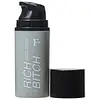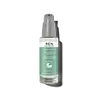What's inside
What's inside
 Key Ingredients
Key Ingredients

 Benefits
Benefits

 Concerns
Concerns

 Ingredients Side-by-side
Ingredients Side-by-side

Water
Skin ConditioningCetyl Ethylhexanoate
EmollientGlycerin
HumectantPropanediol
SolventCocos Nucifera Oil
MaskingSqualane
EmollientButylene Glycol
HumectantCamellia Japonica Seed Oil
EmollientMethyl Trimethicone
Skin ConditioningLimnanthes Alba Seed Oil
Skin Conditioning1,2-Hexanediol
Skin ConditioningCetyl Phosphate
EmulsifyingOpuntia Ficus-Indica Seed Oil
EmollientDioscorea Japonica Root Extract
Skin ConditioningArginine
MaskingSodium Hyaluronate
HumectantOryza Sativa Bran Extract
Skin ConditioningHelianthus Annuus Extract
EmollientRosmarinus Officinalis Leaf Extract
AntimicrobialTocopherol
AntioxidantCetyl Alcohol
EmollientCaprylyl Glycol
EmollientParfum
MaskingSodium Polyacrylate
AbsorbentXanthan Gum
EmulsifyingSodium Phytate
Benzyl Salicylate
PerfumingHexyl Cinnamal
PerfumingLimonene
PerfumingAlpha-Isomethyl Ionone
PerfumingGeraniol
PerfumingWater, Cetyl Ethylhexanoate, Glycerin, Propanediol, Cocos Nucifera Oil, Squalane, Butylene Glycol, Camellia Japonica Seed Oil, Methyl Trimethicone, Limnanthes Alba Seed Oil, 1,2-Hexanediol, Cetyl Phosphate, Opuntia Ficus-Indica Seed Oil, Dioscorea Japonica Root Extract, Arginine, Sodium Hyaluronate, Oryza Sativa Bran Extract, Helianthus Annuus Extract, Rosmarinus Officinalis Leaf Extract, Tocopherol, Cetyl Alcohol, Caprylyl Glycol, Parfum, Sodium Polyacrylate, Xanthan Gum, Sodium Phytate, Benzyl Salicylate, Hexyl Cinnamal, Limonene, Alpha-Isomethyl Ionone, Geraniol
Water
Skin ConditioningCaprylic/Capric Triglyceride
MaskingGlycerin
HumectantPropanediol
SolventCoco-Caprylate/Caprate
EmollientSqualane
EmollientCetyl Alcohol
EmollientCetyl Phosphate
EmulsifyingCrambe Abyssinica Seed Oil
Skin ConditioningArginine
MaskingGlycine Soja Oil
EmollientGlyceryl Stearate
EmollientPhenoxyethanol
PreservativeSodium Dehydroacetate
PreservativeEthylhexylglycerin
Skin ConditioningInulin
Skin ConditioningVaccinium Vitis-Idaea Seed Oil
AntioxidantSclerotium Gum
Emulsion StabilisingTocopherol
AntioxidantSodium Hyaluronate
HumectantAlbatrellus Confluens Extract
HumectantAlpha-Glucan Oligosaccharide
CleansingXanthan Gum
EmulsifyingSodium Carboxymethyl Betaglucan
Biosaccharide Gum-4
Skin ConditioningLaminaria Ochroleuca Extract
Skin ConditioningCitrus Aurantium Amara Flower Extract
RefreshingBeta-Carotene
Skin ConditioningXanthophylls
Skin ConditioningHelianthus Annuus Seed Oil
EmollientRosmarinus Officinalis Leaf Extract
AntimicrobialCitric Acid
BufferingLactic Acid
BufferingSodium Hydroxide
BufferingGeraniol
PerfumingLinalool
PerfumingWater, Caprylic/Capric Triglyceride, Glycerin, Propanediol, Coco-Caprylate/Caprate, Squalane, Cetyl Alcohol, Cetyl Phosphate, Crambe Abyssinica Seed Oil, Arginine, Glycine Soja Oil, Glyceryl Stearate, Phenoxyethanol, Sodium Dehydroacetate, Ethylhexylglycerin, Inulin, Vaccinium Vitis-Idaea Seed Oil, Sclerotium Gum, Tocopherol, Sodium Hyaluronate, Albatrellus Confluens Extract, Alpha-Glucan Oligosaccharide, Xanthan Gum, Sodium Carboxymethyl Betaglucan, Biosaccharide Gum-4, Laminaria Ochroleuca Extract, Citrus Aurantium Amara Flower Extract, Beta-Carotene, Xanthophylls, Helianthus Annuus Seed Oil, Rosmarinus Officinalis Leaf Extract, Citric Acid, Lactic Acid, Sodium Hydroxide, Geraniol, Linalool
Ingredients Explained
These ingredients are found in both products.
Ingredients higher up in an ingredient list are typically present in a larger amount.
Arginine is an amino acid that is important for human development. Your body uses is it to produce hair keratin and skin collagen.
As a cosmetic ingredient, Arginine has antioxidant properties and can also help repair damaged skin. This ingredient is derived either synthetically or from animals.
Arginine isn't fungal acne safe when used in the presence of other lipids (fats, fatty acids, oils, esters, etc). Oils and fats occur naturally within the skin, so take caution when using Arginine if you're prone to fungal acne.
Learn more about ArginineCetyl Alcohol is a fatty alcohol. Fatty Alcohols are most often used as an emollient or to thicken a product.
Its main roles are:
Though it has "alcohol" in the name, it is not related to denatured alcohol or ethyl alcohol.
The FDA allows products labeled "alcohol-free" to have fatty alcohols.
Learn more about Cetyl AlcoholWe don't have a description for Cetyl Phosphate yet.
Geraniol is used to add fragrance/parfum to a product. It is the main component of citronellol. It is a monoterpenoid and an alcohol.
Monoterpenes are naturally found in many parts of different plants.
Geraniol can be found in many essential oils including Rose Oil and Citronella Oil. The scent of Geraniol is often described as "rose-like". Many foods also contain Geraniol for fruit flavoring.
Geraniol can irritate the skin when exposed to air. However, irritation depends on the ability of geraniol to penetrate into the skin. In general, geraniol is not able to penetrate skin easily.
Geraniol is colorless and has low water-solubility. However, it is soluble in common organic solvents.
Like citronellol, it is a natural insect repellent.
2,6-Octadien-1-ol, 3,7-dimethyl-, (2E)-
Learn more about GeraniolGlycerin is already naturally found in your skin. It helps moisturize and protect your skin.
A study from 2016 found glycerin to be more effective as a humectant than AHAs and hyaluronic acid.
As a humectant, it helps the skin stay hydrated by pulling moisture to your skin. The low molecular weight of glycerin allows it to pull moisture into the deeper layers of your skin.
Hydrated skin improves your skin barrier; Your skin barrier helps protect against irritants and bacteria.
Glycerin has also been found to have antimicrobial and antiviral properties. Due to these properties, glycerin is often used in wound and burn treatments.
In cosmetics, glycerin is usually derived from plants such as soybean or palm. However, it can also be sourced from animals, such as tallow or animal fat.
This ingredient is organic, colorless, odorless, and non-toxic.
Glycerin is the name for this ingredient in American English. British English uses Glycerol/Glycerine.
Learn more about GlycerinPropanediol is an all-star ingredient. It softens, hydrates, and smooths the skin.
It’s often used to:
Propanediol is not likely to cause sensitivity and considered safe to use. It is derived from corn or petroleum with a clear color and no scent.
Learn more about PropanediolRosmarinus Officinalis Leaf Extract comes from rosemary. Rosemary is native to the Mediterranean.
While Rosmarinus Officinalis Leaf Oil can be volatile due to its fragrant properties, the fragrance components are usually removed in the leaf extract.
Rosemary Leaf Extract contains many antioxidants such as rosmarinic acid and caffeic acid. Rosemarinic acid, a compound found in rosemary leaf, has been found to help soothe skin conditions such as eczema and acne.
Learn more about Rosmarinus Officinalis Leaf ExtractSodium Hyaluronate is hyaluronic acid's salt form. It is commonly derived from the sodium salt of hyaluronic acid.
Like hyaluronic acid, it is great at holding water and acts as a humectant. This makes it a great skin hydrating ingredient.
Sodium Hyaluronate is naturally occurring in our bodies and is mostly found in eye fluid and joints.
These are some other common types of Hyaluronic Acid:
Learn more about Sodium HyaluronateSqualane is an emollient that helps the skin hold onto moisture. It's an oily liquid that occurs naturally in certain types of fish and plant oils.
Because squalane boosts hydration in the skin, it also comes with plenty of benefits: it is an antioxidant and can help fight free radicals and skin damage. Squalane is also found to have a detoxifying effect when applied.
Squalane comes from squalene, which occurs naturally within the sebum of our skin. It is one of the oils our skin produces to keep itself hydrated. Squalane is the hydrogenated version of squalene and has a longer shelf life.
Research shows that squalane is non-irritating (even at 100% concentration).
In general, it's a fantastic ingredient. It does a great job at hydrating the skin, and it's suitable for those with sensitive skin.
The source of squalane may impact malassezia / fungal acne. This is because olive oil derived squalane can contain impurities such as fatty acids and plant waxes. Sugarcane derived squalane is recommended for anyone with malassezia concerns.
Is squalane vegan?
This depends on the source. Squalane can be derived from both plants and animals. Most squalane used in skincare comes from plants.
Please note: the source of squalane is only known if disclosed by the brand. We recommend reaching out to the brand if you have any questions about their squalane.
Read more about squalene with an "e".
Is squalane an oil?
Squalane is often called an oil, but it’s technically not; it’s a hydrocarbon, meaning it’s only made of carbon and hydrogen, unlike true oils which are triglycerides made of fatty acids and glycerol.
The term “oil-free” isn’t regulated, so companies can define it however they want. Some exclude all oils, while others just avoid mineral oil or comedogenic oils.
While some people avoid oils thinking they cause breakouts, the right kind of oil (or oil-like ingredient like squalane) can actually help balance and hydrate your skin. It’s worth testing out simple oils or squalane to see what works best for your skin.
Learn more about SqualaneTocopherol (also known as Vitamin E) is a common antioxidant used to help protect the skin from free-radicals and strengthen the skin barrier. It's also fat soluble - this means our skin is great at absorbing it.
Vitamin E also helps keep your natural skin lipids healthy. Your lipid skin barrier naturally consists of lipids, ceramides, and fatty acids. Vitamin E offers extra protection for your skin’s lipid barrier, keeping your skin healthy and nourished.
Another benefit is a bit of UV protection. Vitamin E helps reduce the damage caused by UVB rays. (It should not replace your sunscreen). Combining it with Vitamin C can decrease sunburned cells and hyperpigmentation after UV exposure.
You might have noticed Vitamin E + C often paired together. This is because it is great at stabilizing Vitamin C. Using the two together helps increase the effectiveness of both ingredients.
There are often claims that Vitamin E can reduce/prevent scarring, but these claims haven't been confirmed by scientific research.
Learn more about TocopherolWater. It's the most common cosmetic ingredient of all. You'll usually see it at the top of ingredient lists, meaning that it makes up the largest part of the product.
So why is it so popular? Water most often acts as a solvent - this means that it helps dissolve other ingredients into the formulation.
You'll also recognize water as that liquid we all need to stay alive. If you see this, drink a glass of water. Stay hydrated!
Learn more about WaterXanthan gum is used as a stabilizer and thickener within cosmetic products. It helps give products a sticky, thick feeling - preventing them from being too runny.
On the technical side of things, xanthan gum is a polysaccharide - a combination consisting of multiple sugar molecules bonded together.
Xanthan gum is a pretty common and great ingredient. It is a natural, non-toxic, non-irritating ingredient that is also commonly used in food products.
Learn more about Xanthan Gum